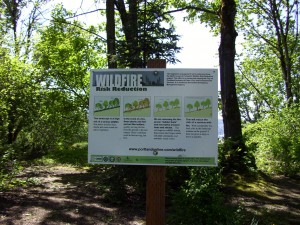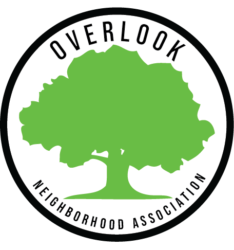A place to store and maintain items of interest from Overlook’s history
Wildfire Risk Reduction
Specific: https://www.portlandoregon.gov/parks/47582
North Escarpment Unit
The 200-acre North Escarpment Unit (Willamette Bluff) rises abruptly from the east bank of the Fremont Bridge and parallels the river northwest to the St Johns Bridge. This unit is composed of several small degraded PP&R natural areas including Willamette Cove, Harbor View Property, Waud Bluff, and Mocks Crest. It also includes parcels of unmanaged lands currently in the jurisdiction of other city bureaus and the Port of Portland, Waud Bluff on the University of Portland campus, and many privately-owned properties.
BACKGROUND
Before European settlement in the mid 1800s, the north escarpment was and still is home to oak/maple/madrone savanna. Land clearing and development practices favored weedy, invasive plant species such as Himalayan blackberry and Scot’s broom.
Fire is a natural part of the oak/maple/madrone savanna, which burned often. Native Americans regularly burned oak savannas to favor oaks, selected plants, and wildlife. Landscape alteration and fire suppression by Euro-Americans over decades contributed to high fuel loads of dense live and dead vegetation, which only need a spark to ignite.
WILDFIRE RISK REDUCTION & HABITAT RESTORATION
The vegetation covering much of the north escarpment is currently dominated by non-native plant species, such as Himalayan blackberry and Scot’s broom. These noxious weeds are highly flammable, provide minimal erosion control compared to grasses, and provide limited wildlife habitat compared to the historical plant community. Benefits of revegetation will include improving wildlife habitat, reducing bank and upland soil erosion, improving water quality, and reducing the severity of wildfires, as well as public education about oak woodlands.
A vegetation inventory conducted by PP&R on the Harbor View and Mocks Crest properties and Madrona Park (Overlook Bowl) from 2002-2003 shows that this area is severely degraded and dominated by invasive plants such as clematis, Himalayan blackberry, Scot’s broom, and non-native grasses.
In 2001, a fire starting near the railroad tracks set these portions of the north escarpment ablaze, burning most of the vegetation on 43 acres of the bluffs. The City conducted an extensive restoration project that included erosion control, native grass seeding, and invasive vegetation removal.
There are many methods of reducing hazardous wildfire fuels such as flammable invasive plant species. A burn conducted in 2002 by Portland Fire & Rescue and the Bureau of Environmental Services along Overlook Bowl in Madrona Park is an example where manual labor, herbicides, and burning have been used to accomplish wildfire risk reduction and habitat restoration goals.
DESIRED FUTURE CONDITION
Funded by a 2006-2009 grant from the Federal Emergency Management Agency, a collaborative process including land management professionals, private land owners, and other interested parties recently identified the Desired Future Condition for this area as oak/maple woodland.
In 2001, an uncontrolled wildfire burned 43 acres on the Willamette Bluffs. Before the fire, high fuel loads from blackberries, Scot’s broom, and other invasive weeds dominated the slope. A spark from a passing train set the hillside ablaze, burning most vegetation. The following spring, native grasses are restored, the result of an extensive restoration project that included erosion control, grass seeding, and invasive weed treatments.
INFORMATION
For additional information about the FEMA Wildfire Risk Reduction Project, please contact:
Mark Wilson, PP&R Ecologist
mwilson@ci.portland.or.us 503-823-6736
North Escarpment Map
This topic is covered in several issues of Overlook Views; see 2006. Steve Lanigan was the Overlook contact/coordinating member of this effort.
More recent fire risk reduction efforts have been made in one portion of the Overlook escarpment by Friends of Overlook Bluff (FOOB) who are working to restore the White Oak Savannah habitat.
